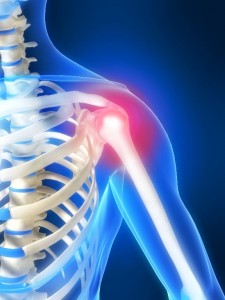Shoulder Rehabilitation
Posted on July 29th, 2011 by Andries Lodder

Rehabilitation of the Shoulder Using Exercise
There are many types of injuries and surgeries that involve the shoulder. The exercise phase of shoulder rehabilitation may begin very early. It is important to understand some basic concepts in order to achieve the best functional return of your arm. Your Biokineticist will provide details specific to your particular injury. Following are some general guidelines for initial shoulder exercises.
Begin by performing exercises slowly and with control. Concentrate on the quality of motion.
- Exercise in a pain-free range. When baseline pain or discomfort arises, exercise in a range that does not increase pain.
- Try to relax while doing your exercises.
- Avoid exercising in a range that causes “popping” in the shoulder.
- Try to keep the shoulder blade down and back while exercising. The motion should come from the true shoulder joint and not from the shoulder blade (unless it is a specific exercise for the shoulder blade).
- Before increasing exercise resistance or speed/rate, consult your Biokineticist.
Shoulder Problems
The shoulder is a ball-and-socket joint that allows for an abundance of varied types of movements. Unlike the hip joint, which is a very stable joint, the shoulder is more closely similar to a bowling ball on a dinner plate. This means that while shoulder has excellent movement, it also can become unstable and susceptible to injury.
Dislocations
The shoulder joint is surrounded by a capsule of tough fibers. If the shoulder is pushed too far in any direction, it can dislocate, which means that the upper arm bone has stretched or torn through the capsule. In addition to tearing the capsule, dislocations can cause fractures to the shoulder socket or tears to the labrum or ligaments. The labrum is a fibrous ring of cartilage (similar to rubber) that helps make the socket deeper. Ligaments are strong fibers that help to hold the shoulder together.
Bursitis
The bursa is a fluid-filled sac in the shoulder that helps reduce friction and protect the muscles from rubbing against the bones. Excessive overuse or improper conditioning can cause irritation the bursa.
Tendonitis/Impingement Syndrome
Tendons attach muscle to the bone. Overuse or improper conditioning can irritate the tendons, causing tendonitis. If the situation becomes chronic, the body begins to deposit calcium in the tendon. Eventually the tendon becomes pasty and will break. This is called calcific tendonitis.
Rotator Cuff Tears
There are four major muscles that attach to the shoulder joint. They are referred to together as the rotator cuff. Injury or excessive overuse can cause a tear in one or several of these muscles.
Arthritis
Another result of wear and tear is arthritis, which is the breakdown or softening of the bone in the shoulder. This generally occurs on the ball and socket and sometimes at the AC joint, which is the “tip” or “point” of the shoulder.
Adhesive Capsulitis
Adhesive capsulitis or “frozen shoulder” is a condition that comes on slowly. The exact cause is not known at this time. The shoulder becomes painful, leading to reduced motion. The joint capsule becomes adhered to other tissues in the shoulder joint, which leads to less range, and the cycle continues until there is no motion left in the shoulder.
Fractures
Fractures usually occur with trauma or a fall, but as noted earlier, can happen with dislocations as well.
Treatment
First phase rehabilitation always done by a Physiotherapist and Final phase rehabilitation by a Biokineticist.
Modalities such as ultrasound, electrical stimulation, heat and cold can enhance healing and provide pain relief for conditions of bursitis, tendonitis, and minor rotator-cuff tears. Biokinetic therapeutic exercise is initiated for range-of-motion recovery, strengthening, conditioning and endurance. Exercise is also helpful for regaining stability in the dislocated shoulder. Manual therapy or hands-on treatment may be necessary for frozen shoulder or situations in which range is limited. With proper care and perseverance with therapy, many shoulder dysfunctions can be resolved.
If a rotator cuff tear, fractures, labral tear or arthritic damage is severe enough, the shoulder may require surgery. If you have any question or concerns, consult your Biokineticist.
Tweet